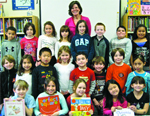 Students at Daniel Warren were recently given a mission they were all too keen to accept. Although it might seem impossible to get first and second graders, as well as kindergarteners, to appraise storybook illustrations with a discriminating eye, then vote for the best one and actually keep it a secret, they passed the test with flying colors!
Students at Daniel Warren were recently given a mission they were all too keen to accept. Although it might seem impossible to get first and second graders, as well as kindergarteners, to appraise storybook illustrations with a discriminating eye, then vote for the best one and actually keep it a secret, they passed the test with flying colors!
By Janice Llanes Fabry
Students at Daniel Warren were recently given a mission they were all too keen to accept. Although it might seem impossible to get first and second graders, as well as kindergarteners, to appraise storybook illustrations with a discriminating eye, then vote for the best one and actually keep it a secret, they passed the test with flying colors!
 “You’re not just choosing your favorite book,” said Media Specialist Linda Costelloe. “Our job’s harder than that. We need to think about where the illustrators bring the stories to life and how they match the mood of the story to the illustrations.”
“You’re not just choosing your favorite book,” said Media Specialist Linda Costelloe. “Our job’s harder than that. We need to think about where the illustrators bring the stories to life and how they match the mood of the story to the illustrations.”
The eager students simulated the duties of the National Caldecott Committee, which annually awards the prestigious Caldecott Medal to the artist of the most distinguished American picture book. The insightful Daniel Warren kids used the same criteria the committee employs – artistic technique, suitable style, and plot depiction.
As classes assembled in the media center, Ms. Costelloe had them recap each of the four contenders. They discussed the childlike, monochromatic illustrations of Paul Schmid for “A Pet for Petunia” in contrast to the more detailed drawings in Kady Macdonald Denton’s “The Queen of France”. They were impressed that Michael Hall used all the colors of the rainbow in “Perfect Square” and that “A Ball for Daisy” relies only on Chris Raschka’s illustrations to tell the entire story without any text at all.
Second grader Abigail Morales preferred “A Ball for Daisy” and spoke for a lot of her peers when she said, “I liked all the details in the drawings and, besides, I’m a pet person.”
Ms. Costelloe explained the curriculum’s progression. “In kindergarten, we start building the foundation, so by the time they’re in the second grade, the students’ discussions about the books are magnified. They become critical thinkers and the new technology fosters a love of reading because it brings them in.”
Not only did students identify each medium used, they had opinions about whether it corresponded with the mood of the story, from the happier feel of watercolor to the more somber feel of oil painting. They made many interesting observations about color, content, and text before voting devices were distributed.
In a flash, Ms. Costelloe pulled up voting results on the SMART board: “A Ball for Daisy” was the winner. It turns out the esteemed Caldecott committee voted the same way.















